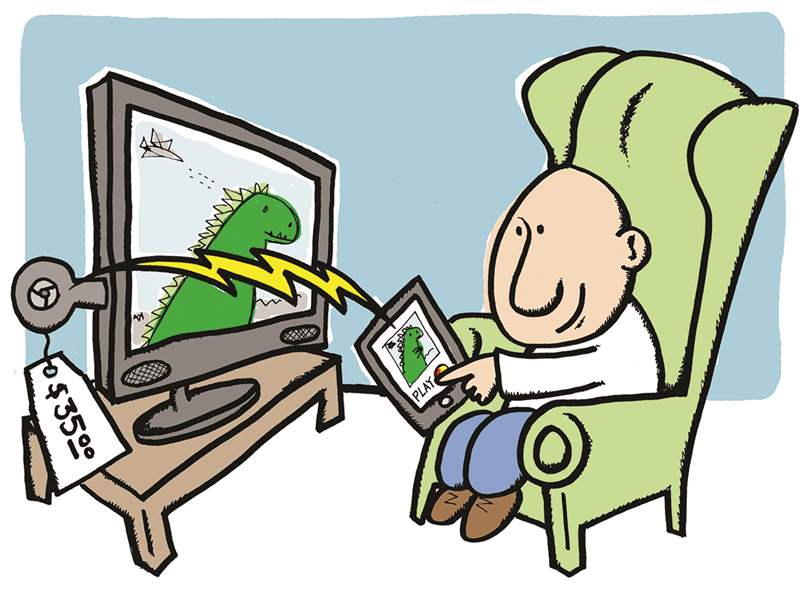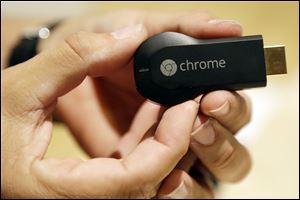
For $35, Chromecast offers good alternative to cable TV
8/3/2013
BLADE ILLUSTRATION BY WES BOOHER

Ever hear the old saying, “Information wants to be free?” Well, here’s a corollary for you: “TV wants to be à la carte.”

Google’s new Chromecast, priced at only $35, adds the Internet to TVs at home via wireless networks.
Take the story of the iTunes music store. The instant somebody offered the chance to buy songs individually, the world changed forever. Hello, music à la carte. Goodbye, Tower Records.
Now it’s cable TV’s turn.
We are engaged in a great civil movement, testing whether that business, or any business so conceived and so dedicated, can long endure. The number of people who cut the cord, or cancel the satellite, in favor of getting all their TV from the Internet is still small — maybe 1 percent of us a year. But the online alternatives to cable TV are growing. And once it becomes simple and easy to get Internet video from our laptops and phones to the actual television, the term “TV drama” will have a whole new meaning.
Actually, that has just happened. Google Inc.’s new Chromecast gizmo is the smallest, cheapest, simplest way yet to add Internet to your TV. It looks like a portly flash drive or maybe a fat keychain — and it costs only $35.
So what does it do? If you have a Wi-Fi wireless network in your home, the Chromecast can perform two useful stunts.
Stunt 1: It lets you watch videos from YouTube, Netflix, and Google Play (Google’s movie and TV store for Android gadgets) on your big screen. You use your phone or tablet (Apple or Android) as a remote control.
Stunt 2: The Chromecast displays Web sites on your TV — by broadcasting from Google’s Chrome browser on your Mac or PC.
Google’s promotional videos depict a fantasy of effortlessness: A hand slides the Chromecast into an HDMI jack on the back of a big-screen TV, clicking like a key into a lock. And then suddenly everything good on the Internet seems to be watchable on that TV, to the ecstasy of many young, attractive, multiethnic, couch potatoes.
The videos leave out the fact that the Chromecast requires power. You can plug it into a power outlet or a USB jack on the TV itself, but either way, the result isn’t as clutter-free as the ads make it seem. Still — $35, remember?
Then you download a setup program, introduce it to your Wi-Fi network, name your Chromecast, and so on. The whole setup process takes about five minutes; a child could do it. (Adults may need slightly longer.)
To perform Stunt 1, you open the YouTube, Netflix, or Google Play app on your phone or tablet. Find a video to play. A special icon appears at the edge of the touch screen, resembling a rectangle with Wi-Fi signal waves in the corner. To begin watching that video on the TV, tap that icon and choose your Chromecast’s name.
Your phone is not actually transmitting anything. The Chromecast gets the video from the Internet directly; you use your phone or tablet only to find the movie and control its playback. You can even adjust the volume using the physical volume keys on the side.
The good news: This arrangement means you can do other things on your phone or tablet during playback, like working in another app or even turning the thing off.
The bad news is that the phone/tablet is the only remote control you’ve got. So if you want to pause, rewind, or mute the video, you first have to find your phone/tablet, wake it up, enter the password if required, and reopen the app that’s doing the playing. It’s not especially graceful.
On Android gadgets, at least the Pause button appears right on the lock screen. You don’t have to unlock the device and reopen the app.
Otherwise, all of this is effortless and excellent. Even if you can already get Netflix and YouTube on your TV because they’re built into the TV, Xbox, TiVo or Blu-ray player, you may prefer the Chromecast; it’s just much easier to search for videos, thanks to the on-screen keyboard and voice dictation.
You can also cue up several videos to play in sequence. That’s especially handy for YouTube videos, which are usually short.
On the other hand, Netflix and YouTube aren’t much. Rival boxes like Apple TV and Roku can bring many other paid and free Internet services to your TV, like iTunes video, Amazon Prime video, HBO Go, Hulu Plus, Vudu, Vimeo, Spotify, Flickr, ESPN, Major League Baseball TV, and others.
Fortunately, Google says that more services are on the way. For example, Pandora radio is up next. Hulu Plus, Vimeo, Redbox Instant, AOL, and eight other companies have all suggested that they’re coming soon.
Besides, you might not have to lose sleep over the wait, thanks to Stunt 2: The ability to broadcast Web pages to your TV from your Mac or PC. Just fire up the Chrome browser, open the site you want, and click that little Chromecast icon on the toolbar. The Web page now appears on the TV, complete with whatever videos you’d like to play.
Now you can sit there on the couch, laptop before you, and call up any darned Internet service you want. Hulu your head off. MLB my guest. HBO Go crazy.
Hard as those Internet services have tried to keep their videos confined to computer screens, the Chromecast flings them onto the TV. An exception: Chromecast doesn’t like the QuickTime format.
It sends only the video, not the audio. Therefore, you can’t play videos from, for example, Apple’s movie-trailer site.
Stunt 2, alas, isn’t as refined or successful as Stunt 1. No wonder Google labels this feature “Beta.”
This time, you really are sending audio and video from your computer through the air. So it doesn’t work well unless you have a newish, high-horsepower computer and a fast, uncluttered Wi-Fi network. And even then, there’s a one-second lag between laptop and TV playback. The video doesn’t always seem as crisp as it does during Stunt 1, either, and some people experience occasional stutters or audio glitches.
Plenty of people are saying that Chromecast is Google’s answer to Apple TV, Roku 3, and Plair, which are compact plastic boxes that also bring hi-def Internet video to the TV — but cost $100.
Truth is, the comparison isn’t quite apt. Those gadgets are a good deal more ambitious. They have their own remote controls and on-screen menus, so you can use them even if you don’t own a phone or computer. They use many more Internet services too. The Apple TV can also display photos and videos from your iPhone or iPad.
But for goodness’ sake, Chromecast is only $35.
That’s already a fine price for what this gadget does, and it will seem better and better the more video apps are made to work with it.